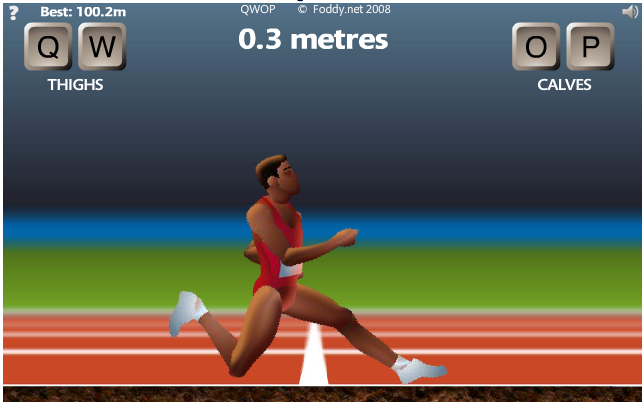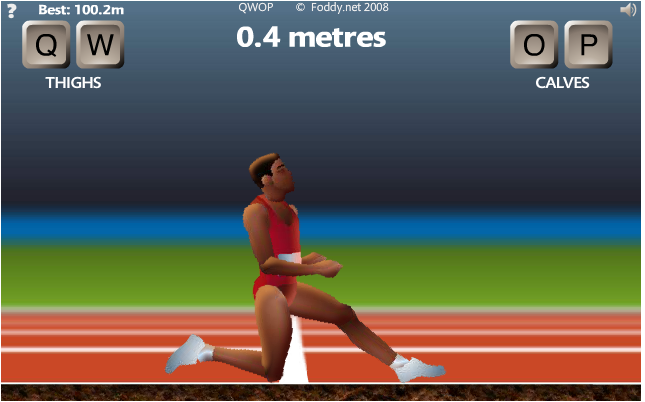Jon Bois has a fun story over on SB Nation today about QWOP, the stupidest, most aggravating, hilarious video game ever made. I enjoyed the reminder about the game, because it illustrates what I wrote on Friday about muscle metaphors.
The example I used on Friday was how I’d think about shooting a free throw in order to correct my posture in other, non-basketball contexts. Using this kind of “muscle metaphor” allows your brain to build a solution for your task more quickly out of existing pathways, instead of trying building it from scratch or some other, less optimal pathway.
One of the reasons QWOP is so difficult is that it seems to defy our ability to find such muscle metaphors. It’s quite unlike any other task you’ve likely tried, and so when we first play the game, we struggle to find any sort of muscular analogy to help our brains cope with this job.
We fail miserably, usually falling flat on our faces or upside down on our heads after just one or two steps. We’re like infants all over again, trying to figure out how these muscles of ours work, kicking our legs this way and that, hoping that eventually, through trial and error, we figure out how to control these things. The “everyone is a winner” message after every failure acts like an encouraging parent, urging us to keep going.
* * *
Eventually, nearly all babies figure out how to walk. But there are often intermediate stages. Babies don’t have a lot of previous motor skills to build on, so they have to construct these pathways from scratch. So a lot of babies crawl before walking, as it’s an easier task to master. Others figure out a kind of butt-scoot, shuffling along while seated, and are satisfied with that form of mobility until they figure out the harder stuff.
QWOP has an equivalent to the butt-scoot, and that’s a kind of one-knee scoot, which works like this:
1. At the start line, press W and P together quickly six times. This will bring the runner down to one knee like this:

2. Then press Q and O together one time, to get the right thigh perpendicular to the ground:

3. Then you scoot along the ground by pressing the pairs of keys together: W/P three times, and Q/O once, over and over. Pressing W and P together three times kicks the left leg out, then Q and O together one time brings the right knee back to parallel.
4. At 50 meters you will reach the hurdle. You can just kind of knock it over. You may need to give an extra Q/O or two to get over it.

5. Then just continue until you get to the finish line at 100m:

* * *
Interestingly, though, this knee scoot method uses the opposite pairs of keys from what you want to use if you’re trying to move the QWOP guy along on two feet. If you’re walking, you want to press Q together with P, and W together with O.
But having mastered the one-knee scoot, walking becomes a little easier. Although the pair of keys we want to press is now the opposite of what we pressed before, we now have some muscle metaphors to build on. We’ve got practice now in pressing these pairs of keys together instead of individually. We’ve also got practice in developing a rhythm to our motion.
And here’s where I finally can find some muscle metaphor from my own experience instead of just the game’s. I find that when I successfully get the QWOP guy to move, I’m actually doing a kind of skipping. I do a long press first, to kick the leg out, and then I do a short little one with the same foot to adjust the leg to where it needs to be so I can successfully get the next leg moving forward. Thinking about skipping gets me in the right frame of mind to get my muscles to press the keys at the right time.
Of course, it’s still not easy even then. The part I still have trouble with now is failure recovery. If I lean forward or back too much, or stick the leg out too far or not far enough, my instincts for correcting the error seem to always be wrong. Half the time, I choose the wrong pair of buttons to push, so I make my mistake worse, not better. Splat.
Mastering failure recovery is also one of the final stages when toddlers learn how to walk. At first, they’ll fall hard to the side or face down, and as a parent, you need to be there to catch them. Eventually, though, all seem to learn how to fall onto their butts, so that they end up sitting after they fall. And finally, the failure recovery gets to be so good that they don’t fall at all.
Then, the next thing you know, your kid is old enough to drive. (My oldest just turned 15 1/2 last month). Then you have to go through this all over again with them, until they’ve mastered the accelerator, brake and steering wheel enough that you know they won’t crash into a tree anytime someone throws a banana at them.
